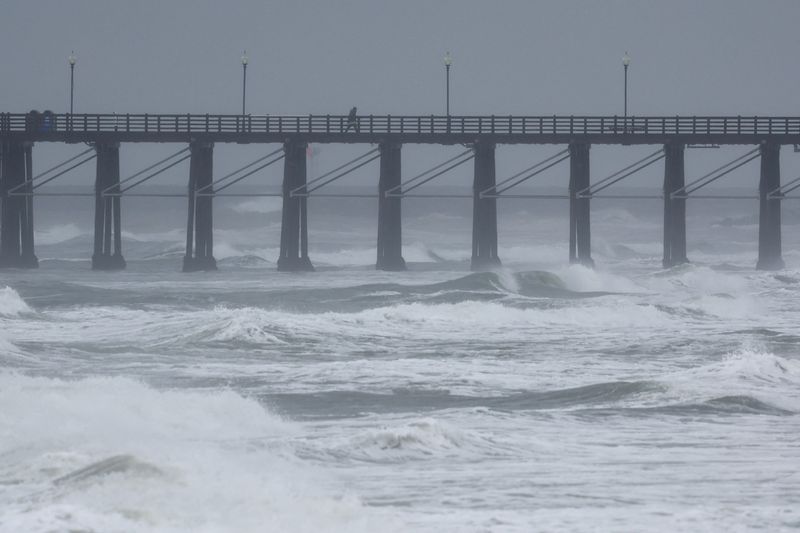By Steve Gorman and Jane Ross
LOS ANGELES (Reuters) -A deadly atmospheric river storm lingered over Southern California for a third day on Tuesday, soaking the region with rains that threatened to trigger more flooding and mudslides as the weather system crept toward the Desert Southwest.
After a day of record-breaking rainfall across the region, a flood watch for Los Angeles County was extended until early Wednesday. A flash-flood warning was posted for the Orange County coast, and flood advisories were issued as far south as San Diego and the U.S.-Mexico border.
A final but short-lived burst of heavy rain was forecast to douse Southern California again on Wednesday afternoon and evening before showers taper off by the week's end.
As rain fell throughout Los Angeles, work crews and residents were cleaning up damage from 475 mudslides and nearly 400 fallen trees reported across the nation's second-most populous city as of Tuesday evening, authorities said.
Downed trees and utility lines knocked out electricity to hundreds of thousands of homes and businesses, including 156,000 utility customers who remained without power in Los Angeles as of Tuesday morning. Service had been restored to most of those by nightfall, city officials said.
L.A. Fire Chief Kristin Crowley said at least three dozen buildings required inspection because of mudslide damage and hillside slope failures. Seven had been marked unsafe for occupancy.
"Even though the rain may ease up a bit today, this storm continues, and that means we still need Angelenos to take precautions," Mayor Karen Bass told a news conference.
'ONCE-IN-A-LIFETIME SCENARIO'
Barry Blocker, 55, a retired police officer, said he spent several hours on Monday digging his car out from a cascade of mud that had poured down a hillside onto his driveway before dawn. The house where he has lived in L.A.'s Baldwin Hills district for 23 years was undamaged.
"Hopefully, it's a once-in-a-lifetime scenario," he said on Tuesday has he stood in his garage, cleaning up water and muck from the aftermath.
Prolonged downpours that dumped 6-12 inches (15-30 cm) of water across the city - and more than a foot in the Hollywood Hills - have left the ground so "super-saturated" that it will take very little additional rain to trigger further landslides and debris flows, said Ariel Cohen, chief forecaster for the National Weather Service (NWS) office in Los Angeles.
The intense rainfall, with heavy snows in the mountains, was carried to California by a storm system meteorologists call an atmospheric river, a vast airborne current of dense moisture funneled inland from the Pacific.
The latest tempest, and a less-powerful storm that hit California last week, also qualified as a "Pineapple Express," a type of atmospheric river originating from subtropical waters around Hawaii.
While such storms are not uncommon to the West Coast, meteorologists say they are likely to become more frequent and extreme over the next century if planetary warming from human-induced climate change continues at current rates.
Scientists say the prevailing El Nino weather pattern is contributing to some of the recent storm activity along the Pacific coast.
“We can’t say that El Nino caused this storm, but a strong El Nino event like this one definitely makes it easier for the atmosphere to produce the kind of pattern conducive for this sort of a system,” said Daniel Swain, a climate scientist and meteorologist at the University of California, Los Angeles.
Swain said another factor accounting for the storm's extreme intensity was that the swirling low-pressure system driving it strengthened so rapidly, reaching "bombgenesis," or bomb-cyclone status, as it first blew ashore in Northern California.
The latest storm kicked off in California with powerful winds gusting to 75 miles per hour (121 kph) and faster across northern and central California on Saturday, before spreading into Southern California early on Sunday.
At least three people were killed when wind toppled trees on Sunday in Sacramento, Santa Cruz and Sutter counties, authorities said.
Over the next few days, flash floods forced widespread street closings across Southern California, and police reported dozens of traffic collisions related to the storm. Numerous neighborhoods deemed especially vulnerable to landslides were placed under evacuation orders and warnings.

While diminished showers lolled over the greater Los Angeles and San Diego areas Tuesday, increasing precipitation was forecast for the California desert and Colorado River Basin as the storm front drifts into Arizona.
In Los Angeles, the onslaught of rain and snow will go down in the record books as one of the wettest storms in more than 150 years, according to meteorologists.
(Reporting and writing by Steve Gorman in Los Angeles; Additional reporting by Jane Ross in Los Angeles, Brendan O'Brien in Chicago and Julia Harte in New York; Editing by David Ljunggren, Sandra Maler and Gerry Doyle)